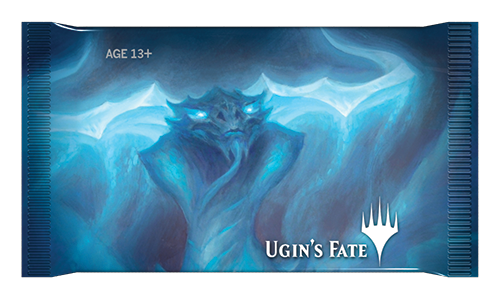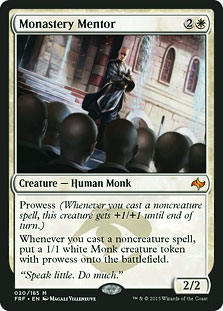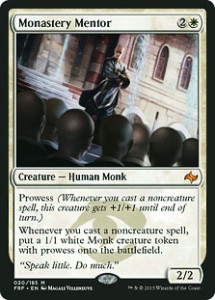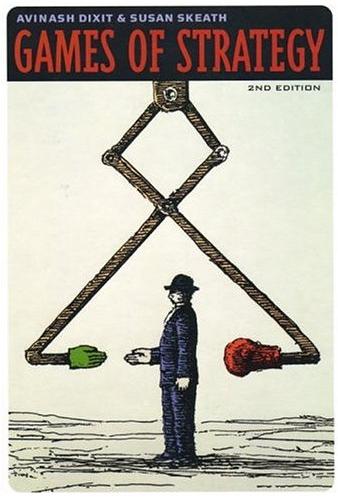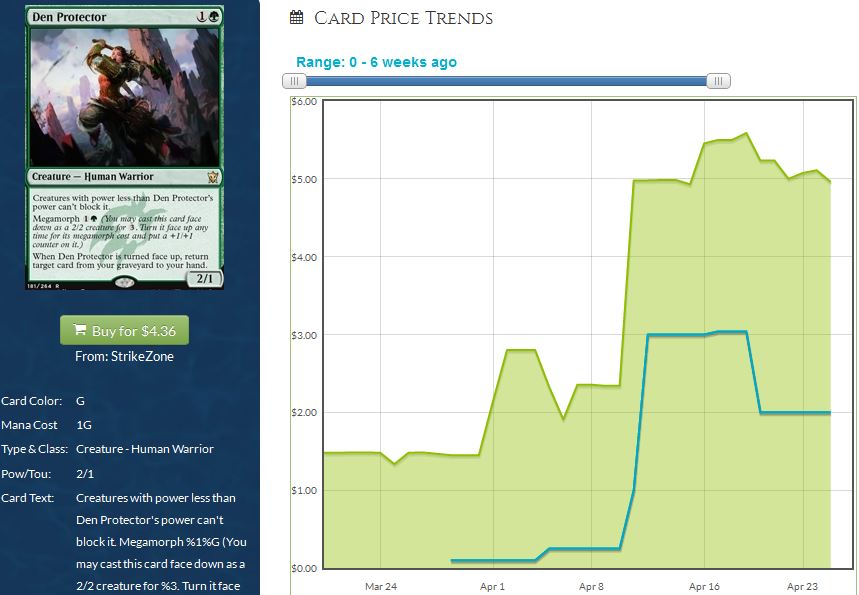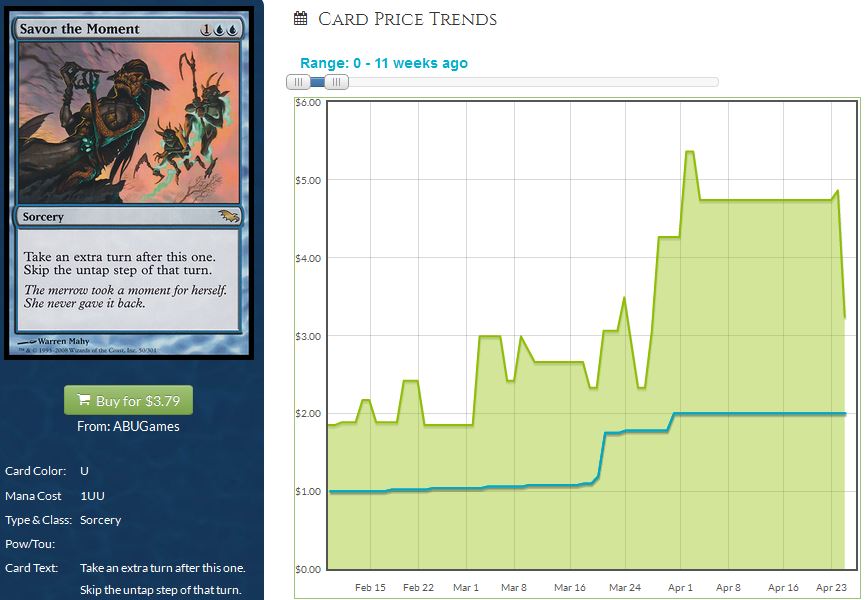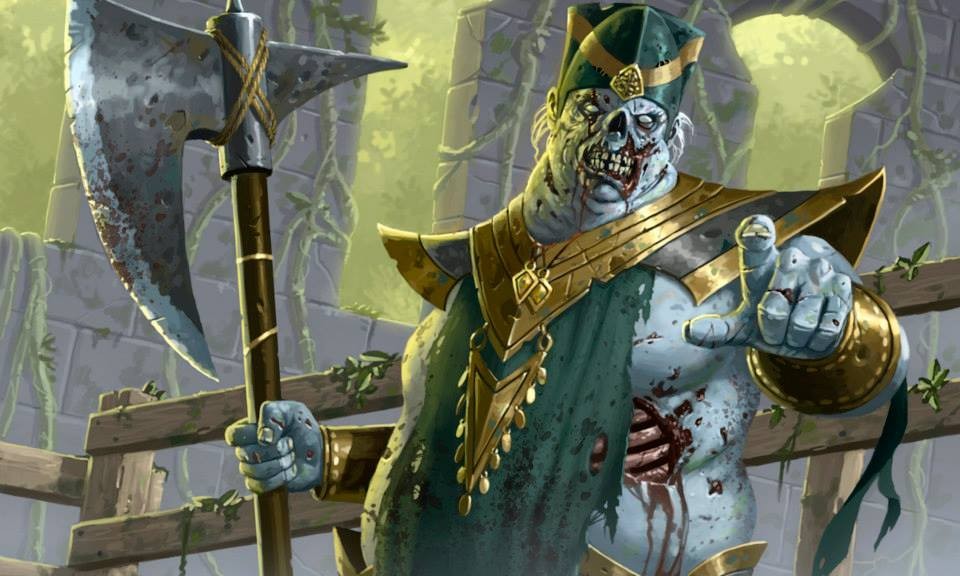By Guo Heng
Today’s article is going to start off by picking up where last week’s article left off before delving into this article’s main topic – the most expensive dragons in Magic’s history – which was inspired by the first segment of this article. I wrote in-depth about Ugin, the Spirit Dragon‘s financial fate last week, and a reader wanted to know more about the future of the Ugin’s Fate alternate art Ugin, which I left out.

I did not discuss the alternate art Ugin in my analysis last week as the article was already approaching 3,600 words and I thought there would not be too many people interested in reading about the finance of an extremely rare card. After all, how many people out there owns one? Turns out I was wrong. There were indeed readers interested in the financial fate of the coveted Ugin’s Fate promo alternate art Ugin, which we shall refer to as ‘Blue Ugin’ from now on, as Ugin looks like he was in cahoots with Heisenberg in Chris Rahn’s art.
Let me start by saying that I had the chance to buy Blue Ugin for $50, but I passed it on. I thought $50 was the ceiling for Blue Ugin. Its not even foil, which lowered its collectibility and price in my eyes. I thought Commander players would prefer to run shiny Ugins in their decks (back then, I assumed Ugin’s eternal play demand – foils- would solely come from the Commander crowd).
I was so wrong.
Apparently a card’s scarcity was a more powerful price driver than I had imagined. Blue Ugin shot up all the way to $200 on eBay following Fate Reforged’s prerelease weekend. In retrospect, it was resoundingly obvious: Blue Ugin was a rare combination of an iconic card and extreme scarcity, and players and collectors were willing to pay Tarmogoyf price for it. Blue Ugin has now settled at $180 on StarCityGames, and around $130 to $150 on eBay as of writing.
I guess I overlooked the fact that the supply of Blue Ugins in the world would be capped at the number of Blue Ugins that were opened over the prerelease weekend.
Or is it?
Judge Foil Blue Ugin?
Here comes the wild card in determining the long-term potential of Blue Ugin. In my previous article, I established that the price of Ugin, the Spirit Dragon is unlikely to tank much as he is one of those rare few cards that has appeal in every single format except for Vintage (for now). Check out the article for my explanation and supporting evidence on how I arrived at that conclusion.
Which means the price of Blue Ugins can only go upward from here, assuming the assumption that the last Blue Ugin was opened on Fate Reforged’s prerelease weekend. However, I am beginning to think it may not be so.
To reiterate what I’ve touched on last week, it makes business sense for Wizards to reuse Chris Rahn’s art for another printing of Ugin, but I doubt Wizards would recycle Chris Rahn’s art for a Duel Deck reprint. Wizards are well aware of the secondary market and they do respect the fact that players and collectors paid a hefty sum for their cards (Good guy Wizards).
I am of opinion that the biggest risk to the price of Blue Ugins is a judge foil reprint. I proposed last week that we would most likely see Blue Ugin as a judge foil within the next few years, rather than a widely accessible reprint. Judge foils have always been used as an avenue to release highly sought after Commander and eternal staples in alternate art form and Ugin definitely fits the bill for a Judge foil reprint. Plus I can’t be the only one who thinks Chris Rahn’s art would look absolutely impressive in foil.
What would a judge foil reprint do to Blue Ugin’s price? I think the current non-foil version would definitely lose some of its allure and price. Blue Ugin commands a higher price than set foil Ugin as Blue Ugin is currently the rarer version. A judge foil reprint would eclipse that and it would garner aesthetic points for being in foil. You know, from Metalworker players who want to foil out their Ugins.
How much would the price of Blue Ugin drop? It’s hard to say for sure, but we can make a deduction based on a few assumptions. First off, we know that the supply of non-foil Blue Ugin from Ugin’s Fate packs would remain the same. There will be a small number of new Blue Ugins entering the market from unopened Ugin’s Fate booster packs being opened some time in the future. For the purpose of our deduction, we can consider that very sight bump in supply to be insignificant.
Secondly, we can assume that the supply of Blue Ugin is likely to be lower than that of the set foil Ugin. Fate Reforged is being drafted for half-a-year, and foil sets are being redeemed off Magic Online. Putting those two assumptions together, it is safe to conclude that the price of Blue Ugin would unlikely drop any lower than set foil Ugin, which is currently at $97, even in the scenario where Blue Ugin is reprinted as a judge foil, based on the merit that Blue Ugins are scarcer.
If we do indeed see a Blue Ugin judge foil in the future, we can assume that the non-foil Blue Ugin would still be more expensive than a set foil Ugin, but at a lower margin than the extra $30 – $50 it is currently enjoying. I am confident that the price of set foil Ugins would go on a gradual upward trajectory like that of the foil Eldrazis. Which means by the time we see a Blue Ugin judge foil, a set foil Ugin could be worth $120 – $130 and even if a non-foil Blue Ugin were to be worth a mere $10 – $20 more, Blue Ugins would probably still command a price range of $130 – $150. Which is it’s current price.
If you happen to own a Blue Ugin, I don’t think they will drop in price, even in the scenario of a judge foil reprint, due to Ugin’s long-term appreciation making up for lost value from reprint. However, if the judge foil reprint does not happen, congratulations, you have just bought a piece of Magic history that could very well have no ceiling in the long-run.
Magic history? While writing about the price of Blue Ugin, being a dragon aficionado and collector, I pondered about where Blue Ugin would rank among the most expensive dragons in Magic’s twenty-two year history. Which led me to dig through the price of all the dragons ever printed in Magic.
Here are the seven most expensive dragons in Magic.
7. Nicol Bolas From the Vaults: Dragons Foil, $46.40
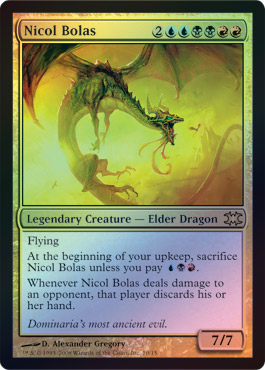
It is slightly ironic that Ugin’s archnemesis, Nicol Bolas follows Ugin on the list of most expensive dragons, although here we see Nicol Bolas in his younger, svelter, pre-planeswalker-spark Elder Dragon body.
Nicol Bolas is the only dragon on this list whose price I am unable to explain. All his other printings, including the Time Spiral foil are not worth much. Nicol Bolas has been hovering around $50 for years and he is not exactly popular as a commander. Maybe it’s D. Alexander Gregory’s new art in which Bolas was described as one who looks like he works out at the gym after a hard day of charring souls and crushing cities.
6. Scion of the Ur-Dragon Foil, $74.01
Scion of the Ur-Dragon has always enjoyed a high foil multiplier, being the sole go-to commander for five-color dragons. Scion foils were hovering around the $30s for years on the back of Commander demand. Foil Scion spiked to $50 at the end of last year in anticipation of the influx of dragons from Dragons of Tarkir and once more to $70 in the middle of March this year.
Scion of Ur-Dragon is pretty insane with the addition of the young versions of the Dragonlords from Fate Reforged that grant your dragons a trigger when they attack. An alpha strike with Ojutai, Soul of Winter and a Scion mimicking Nicol Bolas is good times. Don’t get me started on Atarka, World Render.
5. Foil Scourge of the Throne, $91.97
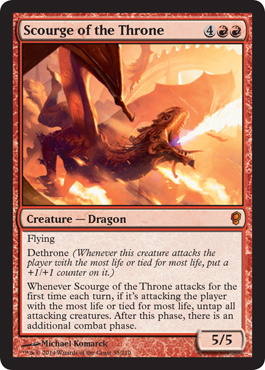
Scourge of the Throne spiked in early March from $7 to $15 and its foil went from $60 to $90. As with Scion of the Ur-Dragon, Scourge of the Throne’s price was driven solely by Commander demand, explaining its high foil price.
Scourge seems to be designed with Commander in mind. It has a splashy effect that is viable in no other format but Commander, and Scourge allows you to dabble in the politics of Commander games (unlike say, Thundermaw Hellkite who just Hulk smashes an unfortunate opponent).
Conspiracy is a set chock-full of Commander and eternal-playable cards, as is prevalent from the huge foil multiplier the set’s most expensive cards command. While the set’s print run was not limited, it is fading further and further away into the recesses of time. Conspiracy was well received and there are rumors about the possibility of Conspiracy 2 next year.
4. Niv-Mizzet, the Firemind 2006 Champs Foil, $129.99
Wizards have a thing with promos. Players love them, and Wizards loves handing them out as event prizes or participation promos. Most of the time they are worth little, but they are some the most beautiful cards to see the light of day. Sometimes they are worth quite a little. Occasionally we stumble upon one that is worth a fortune.
The full art foil Champs promo Niv-Mizzet, the Firemind is in the later category.
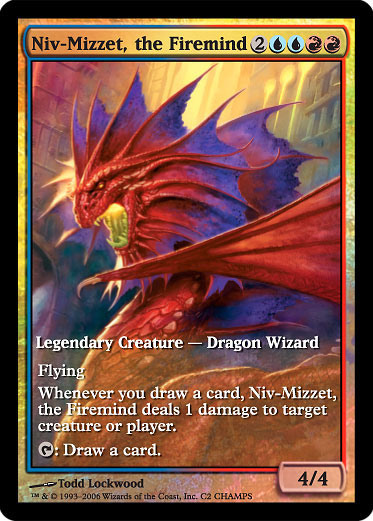
Foil full art Niv-Mizzet was given out to the winners of Champs in 2006. It’s easy to see why Niz-Mizzet is worth so much. Todd Lockwood’s art is drop-dead gorgeous, Niv-Mizzet is a fun (or broken) commander, and Niv-Mizzet is one of the coolest dragons in Magic lore.
The only downside is the removal of Niz-Mizzet’s flavor text. The Guildpact version of Niv-Mizzet had one of the coolest flavor text in any Magic card. The one from the From the Vaults: Dragons version is pretty witty too.
3. Blue Ugin, $165.00 – $179.99

Near-mint copies of Blue Ugin could be found on TCGPlayer from $165 and StarCityGames is doing him for $179.99. eBay listings were closing at $130 – $150 as of writing. I’ve ranked Blue Ugin based on his retail price here as the other dragons were ranked similarly.
2. Zodiac Dragon, $263.99
Zodiac Dragon comes from the extremely difficult to find Portal Three Kingdoms set which was sold only in the Asian market. Home to inordinately expensive Legacy key pieces like Imperial Recruiter and Imperial Seal, and Commander high-end cards like Ravages of War and Capture of Jingzhou, Portal Three Kingdoms boasts one of the highest total set price among all Magic sets. Zodiac Dragon was one of the 12 Zodiac creature cycle, all of which are worth nought except for Zodiac Dragon.
Zodiac Dragon sees no play in any format, and the dragon’s stats are considered disappointing in this age of Magic. Zodiac Dragon nevertheless commands a price tag higher than that of Tarmogoyf courtesy of being one of the rarest dragons in Magic. And that art. Is the dragon flying or running?
1. Alpha Shivan Dragon, $1599.99
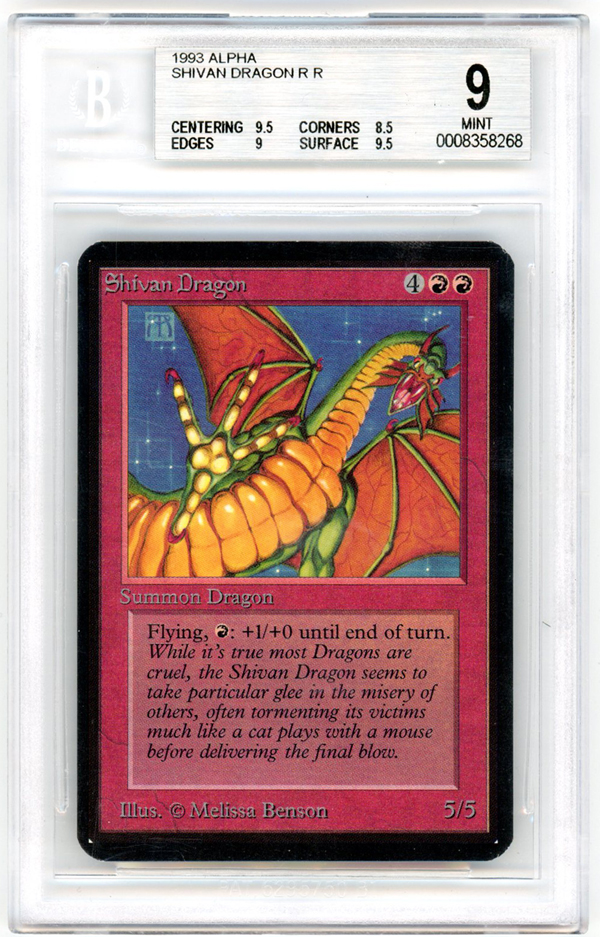
I was surprised that the most expensive dragon you could buy was not Zodiac Dragon, but rather a near-mint BGS 9 Alpha Shivan Dragon from StarCityGames.
An Alpha Shivan Dragon is veritable piece of Magic history. It was the first dragon in Magic. It shaped the way red turned out to be in the color pie, as Richard Garfield recalled in booklet found in From the Vaults: Dragons:
The biggest effect of Shivan Dragon on how the Magic game turned out may be that it’s the biggest reason red has flying. Of course, Magic had to have a dragon, and what with the fire and the destruction and the traditional mountain home, it was a shoo-in for red. But it also had to fly, and red was the magic of earth – the least likely element to get airborne. This was wrestled with for a while, and eventually we decided that big fliers in red were okay. But without Shivan Dragon leading the way, perhaps fliers in red would be as rare as direct damage in blue!
And Shivan Dragon was one of the first chase rares in Magic. It was rumoured to be worth as much as a Black Lotus during the early days of Magic ($25). A big portion of the price of the Shivan Dragon above stems from the fact that it is a BGS-graded Alpha card. An near-mint ungraded one is just $999.99, and would still top the table of most expensive dragons in Magic.
The Priceless One
One more thing.

Shichifukujin Dragon was not on the most expensive list because it is one of a kind. As in there is only one Shichifukujin Dragon in the world, and as with unique object like these, they are priceless.
Shichifukujin Dragon was created to commemorate the opening of the DCI Tournament Centre in Tokyo and I believe it is still hanging there. Mark Rosewater regaled the story of how Shichifukujin Dragon came into existence in an article written ten years ago. Below is an excerpt from Mark’s article:
To commemorate the opening of the DCI Tournament Center, Wizards was asked if they could design and draw (just as I designed both cards, Chris Rush illustrated both of them – back then he was a full-time Wizards employee) a card called Shichifukujin Dragon. Shichifukujin is the name of the Seven Deities of Good Fortune in Japanese mythology. The card was very symbolic as it was supposed to bring good luck to the DCI Tournament Center. Chris Rush drew a lovely picture. And just as it was about to go off to press, it occurred to someone, “Hmm, perhaps it might be cool to put actual rules text on the card.”
So they came to me. They needed a cool mechanic that matched the name and art. Oh, and I had an hour. As the art had to be a seven-headed dragon, I looked for a mechanic that played into the card’s seven-headedness. That is where I came up with the idea of the seven +1/+1 counters. Somehow seven heads got me thinking of hydras and I came up with the idea that it could grow new heads. But to do so it had to make itself more vulnerable for some duration of time. As I played around with the card I came up with the idea of losing two +1/+1 counters to get three… at the end of the turn. I quickly had the rules text templated (by a trained professional – I know better than to get involved in templating) and handed off the card.
There you go. The most expensive dragons in Magic’s history. If you know of any dragons I’ve missed after painstakingly browsing through every card in Gatherer with ‘dragon’ in its name or text and checking its price, do share with me in the comments below, or catch me on Twitter @theguoheng. Do drop a comment below too, or tweet to me if you just want to share you love of dragons.
